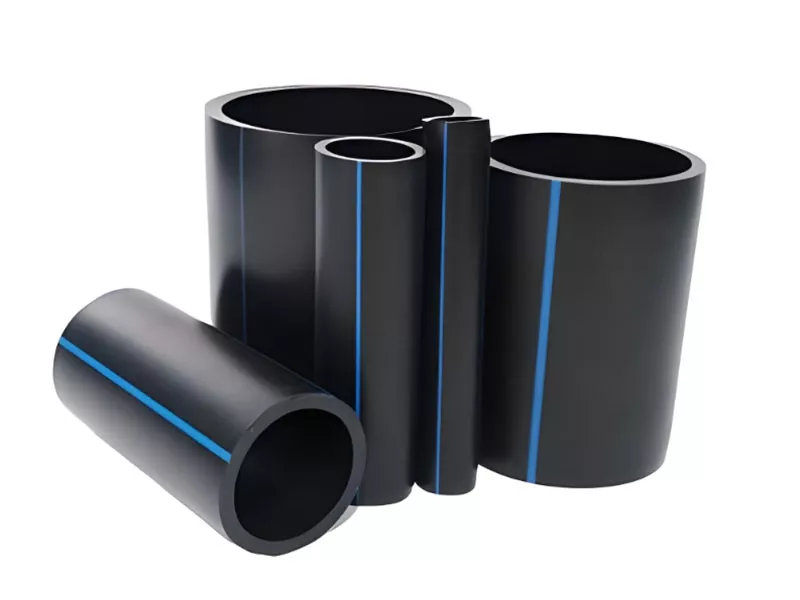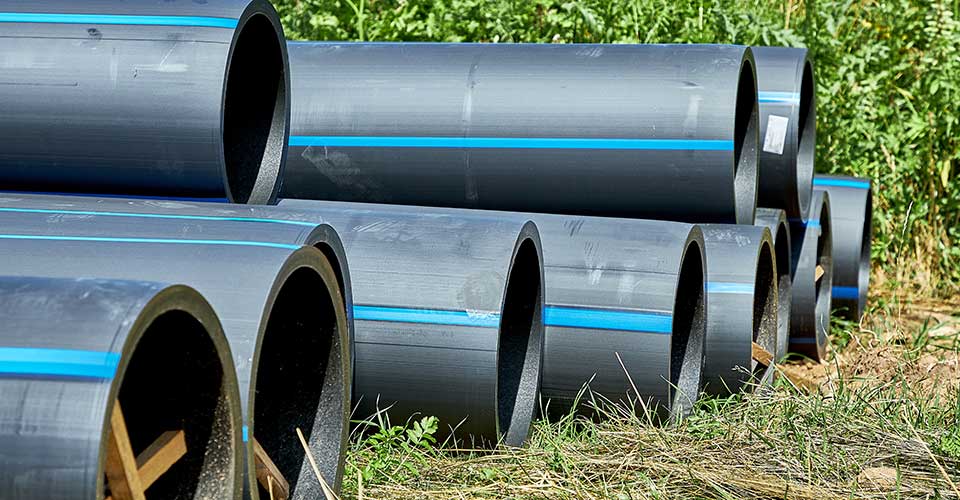Discover the Manufacturing Refine Behind High-Quality HDPE Pipe and Its Applications
The production procedure of premium HDPE pipes is detailed and systematic. It starts with the option of basic materials that improve performance. Following this, ethylene goes through polymerization to develop material, which is then formed via extrusion. Quality assurance is critical, ensuring that the end product satisfies rigid criteria. The trip of HDPE pipes doesn't end with production. Their applications across numerous industries reveal a wider importance worth examining.
Understanding HDPE: Properties and Advantages

High-density polyethylene (HDPE) is a flexible polycarbonate known for its resilience and resistance to numerous ecological factors. This product exhibits excellent tensile strength, making it ideal for demanding applications. Its low-density framework adds to a light-weight product, helping with convenience of taking care of and setup. HDPE likewise showcases amazing resistance to chemicals, which decreases deterioration when revealed to extreme substances.
The material's reduced dampness absorption better improves its long life, making it excellent for usage in pipes and tank. Furthermore, HDPE is resistant to ultraviolet (UV) radiation, making certain that products preserve their integrity also when exposed to sunshine. Furthermore, its flexibility permits for the creation of elaborate forms without jeopardizing strength. The green nature of HDPE, typically stemmed from recycled products, adds to its charm, advertising sustainable techniques in production. In general, these homes and benefits make HDPE a preferred selection for different commercial and customer applications.
Basic Material Selection for HDPE Production
The selection of resources for HDPE production is necessary to verify the last item satisfies the desired specifications and high quality requirements. High-density polyethylene (HDPE) is mainly produced from polymerized ethylene, stemmed from nonrenewable fuel sources such as all-natural gas or crude oil. The high quality of these feedstocks significantly affects the mechanical and thermal buildings of the last HDPE.
Ingredients likewise play a significant role in boosting HDPE's efficiency, consisting of antioxidants, UV stabilizers, and colorants, which boost toughness and resistance to ecological aspects. The option procedure need to take into consideration not only the chemical composition of the raw products yet additionally their handling qualities to guarantee reliable production.
The sourcing of raw products need to prioritize sustainability and conformity with ecological guidelines, as accountable practices are crucial in today's market. Eventually, mindful basic material option lays the structure for creating high-quality HDPE pipes ideal for varied applications.
The Extrusion Process: Shaping HDPE Pipeline
The extrusion procedure plays a crucial function fit HDPE pipes, starting with meticulous product preparation methods that assure perfect circulation and consistency. Similarly vital is the design of the die, which straight affects the last measurements and surface area top quality of the pipe. Together, these elements contribute greatly to the effectiveness and top quality of HDPE pipeline production.
Material Preparation Techniques
Effective manufacturing of HDPE pipelines starts with meticulous material preparation methods, specifically the extrusion procedure. Throughout this stage, high-density polyethylene resin is first dried to eliminate wetness, ensuring excellent circulation features. The material is after that fed right into the extruder, where it undertakes heating and melting, changing right into a viscous state. This heating process is very carefully regulated to keep the product's stability and performance. The molten HDPE is required through a die, shaping it right into a continual pipeline type. Appropriate temperature level management during extrusion is necessary, as it straight influences the product's residential properties and the last product quality. When shaped, the HDPE pipeline is cooled and cut to specified sizes, all set for subsequent handling and applications.
Die Design Significance
Precision in die layout plays a crucial duty in the extrusion procedure of HDPE pipelines. The die functions as the last shaping tool, directly influencing the pipeline's dimensions, wall thickness, and surface area finish. A well-designed die warranties consistent material circulation, lowering problems such as irregularities and vulnerable points. The geometry of the die have to be enhanced to accommodate the specific residential properties of HDPE, including its viscosity and thermal behavior during extrusion. Furthermore, the cooling price of the material as it goes through the die can considerably impact the pipeline's architectural stability. Consequently, purchasing innovative die technology is crucial for producers intending to produce top quality HDPE pipelines that satisfy industry criteria and customer expectations.
Quality Control Steps in HDPE Production
Although numerous aspects affect the top quality of HDPE pipeline production, efficient quality assurance measures are vital to assure uniformity and dependability in the end product. Key quality assurance methods include extensive material inspection, verifying that the raw polyethylene satisfies well established requirements for purity and thickness. Throughout the extrusion procedure, specifications such as temperature, stress, and cooling time are carefully kept track of to preserve dimensional accuracy and structural stability
On top of that, post-production screening is essential; suppliers usually perform hydrostatic tests to assess the pipeline's toughness and resistance to pressure. Aesthetic examinations for surface defects further boost quality control. Certification from relevant criteria organizations, like ASTM or ISO, provides an added layer of reliability. By implementing these comprehensive quality assurance steps, producers can reduce issues, improve efficiency, and ensure that the HDPE pipelines fulfill the particular requirements of numerous applications, inevitably resulting in consumer complete satisfaction and rely on the product.
Applications of HDPE Pipeline Across Industries
HDPE pipelines are used throughout numerous industries because of their sturdiness and flexibility. In water circulation systems, they assure reliable distribution, while in wastewater administration, they give dependable options for waste transportation. Furthermore, farming watering networks profit from HDPE's resistance to corrosion and versatility, making it an optimal option for modern-day farming practices.

Water Circulation Systems
A substantial number of markets count on high-density polyethylene (HDPE) pipelines for effective water circulation systems. Recognized for their sturdiness and resistance to deterioration, HDPE pipelines are widely utilized in municipal water networks, agricultural watering, and commercial applications. Their lightweight nature assists in very easy handling and installation, minimizing labor expenses and time. In addition, HDPE pipes can suit numerous stress degrees, making them ideal for both low and high-pressure systems. Texas hdpe pipe manufacturer. The flexibility of the material enables seamless combination into existing framework, decreasing the demand for considerable excavation. HDPE's resistance to chemical leaching warranties that the water delivered stays risk-free and clean, making it a suitable choice for preserving the high quality of drinkable water across different markets.
Wastewater Management Solutions
Efficient water distribution systems additionally lead the way for ingenious wastewater monitoring options, where high-density polyethylene (HDPE) pipelines play a significant function. Prominent for their toughness and resistance to rust, HDPE pipelines are ideal for carrying wastewater in different settings. Their adaptability permits easy installation in complex settings, minimizing the need for substantial excavation. In addition, HDPE's smooth indoor surface minimizes rubbing, enhancing circulation rates and efficiency. These pipelines are additionally immune to chemical leaching, ensuring that contaminants do not jeopardize the surrounding setting. Industries, districts, and therapy centers significantly depend on HDPE pipelines for their integrity and durability, making them a favored selection for modern-day wastewater administration systems. This versatility highlights the vital importance of HDPE pipelines throughout various applications.
Agricultural Irrigation Networks
Agricultural watering networks benefit greatly from making use of high-density polyethylene (HDPE) pipes, which offer efficient and reputable water shipment to plants. HDPE pipes are lightweight, making them easy to transport and mount, while their adaptability enables various arrangements in diverse surfaces. These pipes demonstrate outstanding resistance to deterioration, chemicals, and UV radiation, making sure toughness in rough farming atmospheres. In addition, their smooth interior surface area reduces friction loss, maximizing water flow and minimizing energy costs related to pumping. The durability of HDPE pipelines, typically exceeding half a century, adds to lower maintenance and substitute expenses. Farmers significantly depend on HDPE pipelines to boost irrigation performance and promote sustainable agricultural methods, ultimately leading to boosted plant returns and source preservation.

Future Fads in HDPE Pipe Innovation
As the need for sustainable and effective infrastructure grows, improvements in HDPE pipe innovation are positioned to change various industries. Arising fads include the combination of wise innovations, such as sensing units and IoT capabilities, which assist in real-time surveillance of pipeline conditions, reducing maintenance costs and avoiding leaks. In addition, the development of advanced manufacturing methods, such as 3D printing, is making it possible for the manufacturing of complex, customized pipe designs that satisfy specific project requirements.
Additionally, the emphasis on recycling and round economy methods is driving the advancement of HDPE pipelines made from recycled products, improving sustainability. Improved jointing approaches, such as electro-fusion and mechanical fittings, are also boosting setup effectiveness and integrity. Ultimately, the growing emphasis on ecological regulations is pressing manufacturers to adopt greener manufacturing procedures, making certain that HDPE pipes not just fulfill market standards but likewise promote a more lasting future here for facilities advancement.
Regularly Asked Inquiries
Exactly How Does HDPE Contrast to Other Plastic Products?
HDPE outperforms many various other plastic materials regarding longevity, chemical resistance, and versatility. Its reduced density and high tensile toughness make it optimal for numerous applications, commonly exceeding alternatives in both efficiency and long life.
What Are the Environmental Effects of HDPE Manufacturing?
The ecological impacts of HDPE production consist of greenhouse gas emissions, energy consumption, and prospective pollution from producing procedures. Additionally, improper disposal can cause dirt and water contamination, raising problems regarding long-term ecological impacts.
Can HDPE Piping Be Recycled?
Yes, HDPE pipes can be recycled. Numerous centers approve used HDPE for processing, transforming it right into new products. This recycling contributes to sustainability efforts, reducing plastic waste while preserving sources and power in the production cycle.
What Is the Lifespan of HDPE Pipeline?

Exactly How Do Temperature Level Variants Impact HDPE Pipeline Performance?
Temperature variants greatly affect HDPE pipeline performance, impacting adaptability and toughness. High temperature levels can lead to softening, while reduced temperatures may cause brittleness, eventually influencing the pipeline's durability and suitability for various applications in diverse settings.